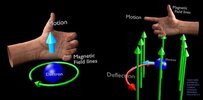abebarker
New Member
- Messages
- 15
I had to come up with my own hand rules for the electron because there were no hand rules for the electron. Current thinking is backwards.
The index finger of the right hand indicates the direction that the electron is moving. The thumb is the direction of the magnetic field, for the earth the magnetic field comes out of the south pole goes up and enters at the north pole. It it just the opposite of the north seeking pole and south seeking pole of a bar magnet. The rest of the fingers naturally curl in the direction that electrons will be deflected by the magnetic field.
These are much more natural and intuitive gestures than the current hand rules use.
I HAD to come up with my own hand rules to even be able to think clearly about electricity. It was not long after I came up with these rules that I recognized the principle that I call the fluxcapacitor effect.
The index finger of the right hand indicates the direction that the electron is moving. The thumb is the direction of the magnetic field, for the earth the magnetic field comes out of the south pole goes up and enters at the north pole. It it just the opposite of the north seeking pole and south seeking pole of a bar magnet. The rest of the fingers naturally curl in the direction that electrons will be deflected by the magnetic field.
These are much more natural and intuitive gestures than the current hand rules use.
I HAD to come up with my own hand rules to even be able to think clearly about electricity. It was not long after I came up with these rules that I recognized the principle that I call the fluxcapacitor effect.

